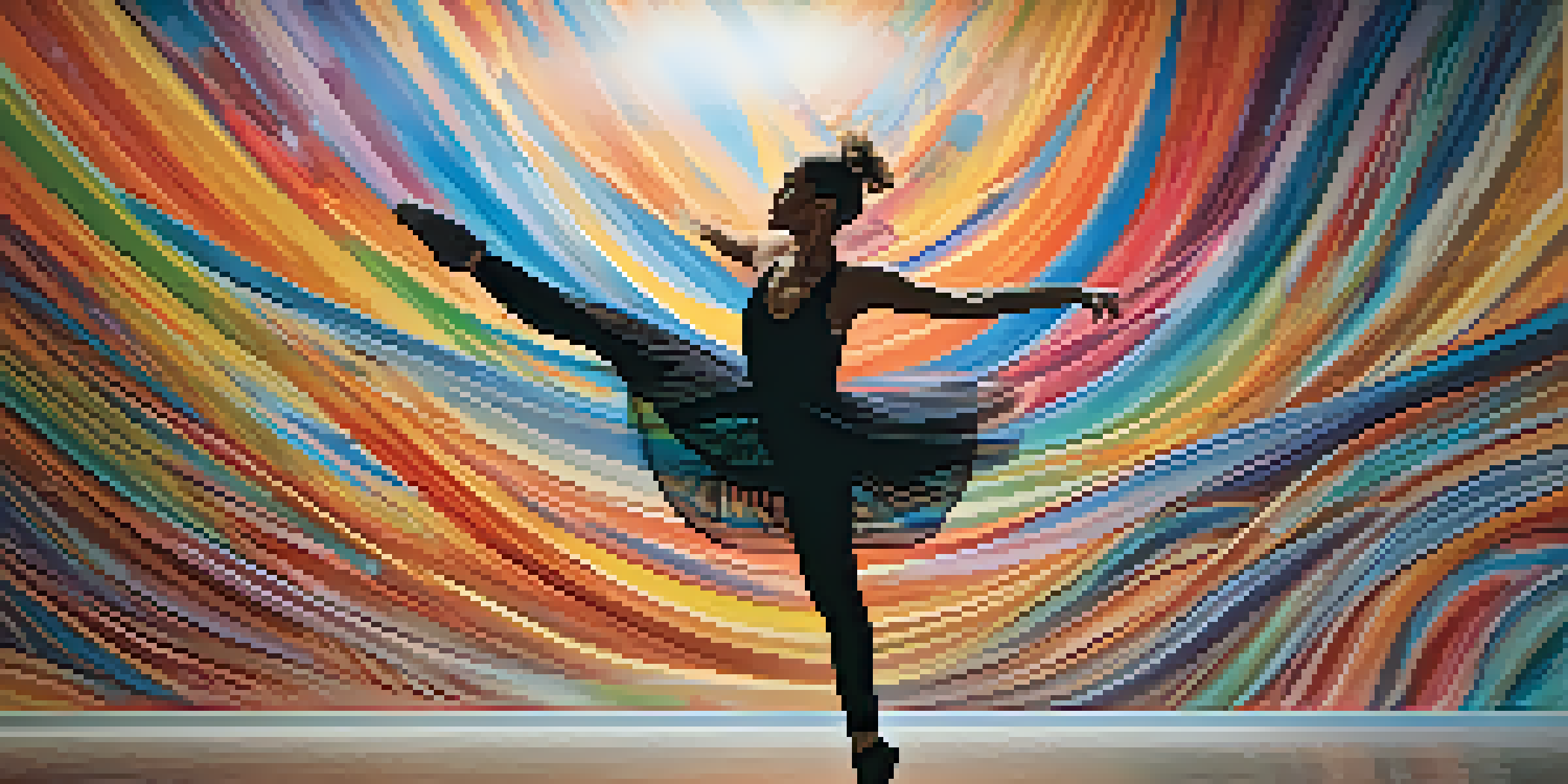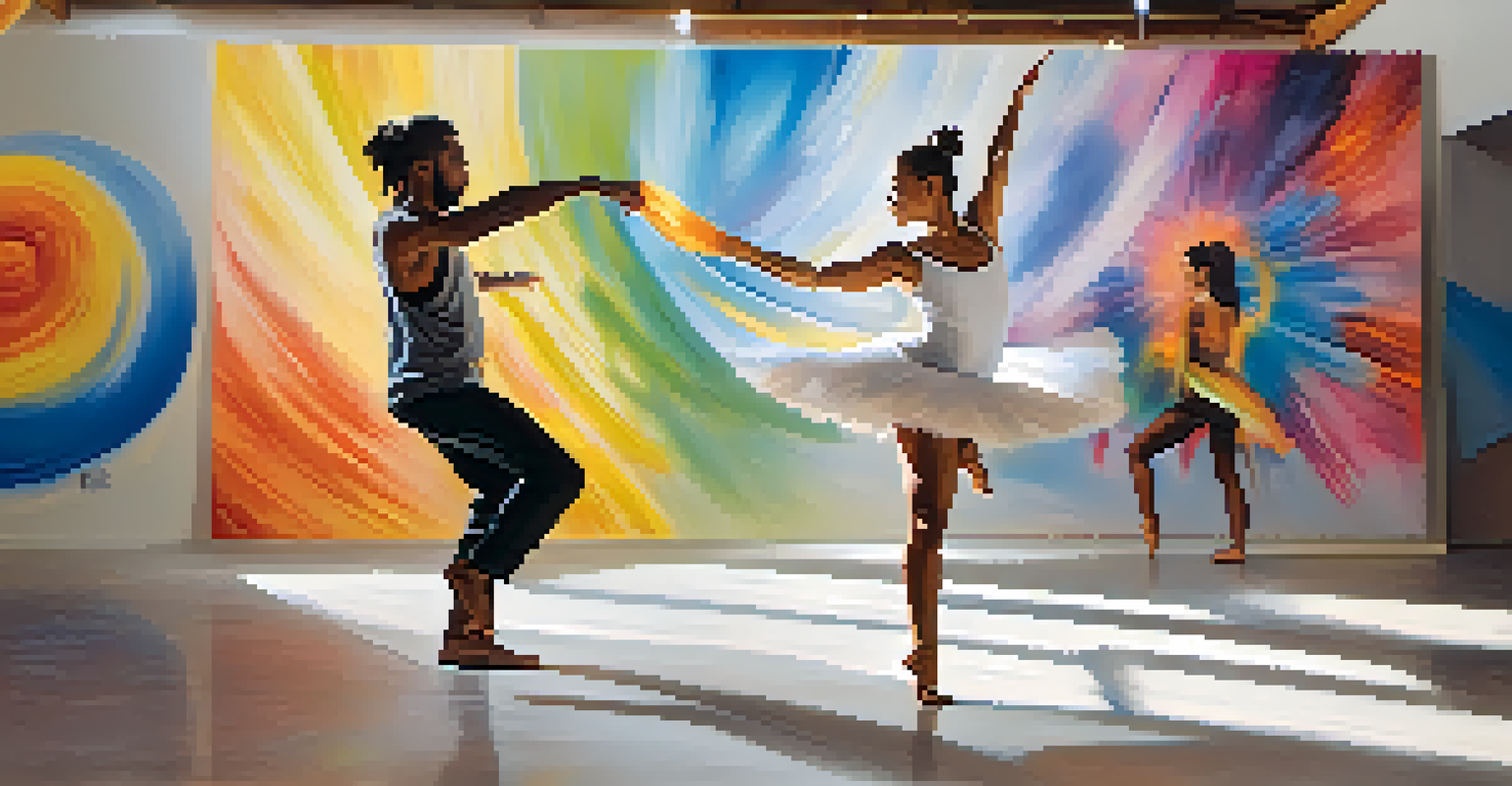Performance Art: The Fusion of Dance and Visual Arts

Understanding Performance Art: A Unique Blend of Disciplines
Performance art is an intriguing form of expression that combines various artistic disciplines, particularly dance and visual arts. Unlike traditional art forms, it emphasizes the artist's live presence and the dynamic interaction with the audience. This approach allows for a unique storytelling experience that unfolds in real time, making every performance distinct and unforgettable.
Art is not freedom from discipline, but disciplined freedom.
At its core, performance art challenges the conventional boundaries of art, inviting viewers to engage in a multi-sensory experience. The integration of movement, visual elements, and sometimes even sound creates a rich tapestry that stimulates both the mind and emotions. This fusion makes performance art a powerful medium for exploring themes of identity, culture, and society.
Artists often draw inspiration from their personal experiences or current events, infusing their performances with deep meaning. For example, a dance piece may incorporate visual projections that reflect the artist's thoughts on climate change, creating a poignant commentary that resonates with the audience. By engaging with both dance and visual arts, performance art opens up new avenues for expression and connection.
The Role of Dance in Performance Art: Movement as Expression
Dance serves as a crucial component of performance art, where movement becomes a powerful language of its own. Through choreography, artists express emotions and narratives that words alone cannot convey. This physicality invites viewers to interpret the performance in their own way, creating a personal connection to the artwork.

Different dance styles contribute to the diversity of performance art, whether it be contemporary, ballet, or even street dance. Each style brings its own vocabulary and cultural significance, enriching the overall experience. For instance, a contemporary dance may incorporate elements of improvisation, allowing the artist to respond spontaneously to the visual elements surrounding them.
Performance Art Merges Disciplines
It uniquely combines dance and visual arts to create a multi-sensory storytelling experience.
Moreover, the fluidity of dance allows for a seamless integration with visual arts. Imagine a dancer moving gracefully in front of a mural that morphs and changes in response to their movements. This interplay not only captivates the audience but also enhances the narrative, making the performance an immersive experience.
Visual Arts: Enhancing the Performance Experience
Visual arts play a pivotal role in performance art by providing a stunning backdrop and context for the dance. Artists often use elements like painting, sculpture, and multimedia projections to create an environment that complements the movement. This synergy transforms the performance space into a dynamic canvas where visual and physical art coexist harmoniously.
The more I read, the more I acquire, the more certain I am that I know nothing.
For example, a performance might feature a live painter creating a mural that evolves alongside the dancers. As the dancers express their emotions through movement, the painter captures that energy on canvas in real-time. This collaboration not only enriches the visual experience but also highlights the interconnectedness of various art forms.
Additionally, visual arts can serve as a source of inspiration for choreographers. The colors, shapes, and themes present in a painting might influence the movements and structure of the dance. This back-and-forth relationship between visual arts and dance fosters innovation and creativity, pushing the boundaries of both disciplines.
Famous Performance Artists Merging Dance and Visual Arts
Throughout history, numerous artists have gained recognition for their innovative approaches to performance art, seamlessly blending dance and visual arts. One notable example is Marina Abramović, whose powerful performances often utilize physical movement and striking visual elements to convey profound messages. Her work invites the audience into an intimate space, challenging them to confront their own emotions.
Another influential artist is Bill T. Jones, known for his groundbreaking choreography that incorporates visual storytelling. His performances often address social issues, using dance as a means of raising awareness and provoking thought. By combining compelling visuals with powerful movement, Jones creates a dialogue that resonates deeply with audiences.
Audience Engagement is Key
The active participation of the audience transforms each performance into a collaborative event.
These artists exemplify how the fusion of dance and visual arts can lead to transformative experiences. Their work not only entertains but also prompts viewers to reflect on important themes, demonstrating the potential of performance art as a vehicle for social change.
The Impact of Technology on Performance Art
In recent years, technology has revolutionized the landscape of performance art, providing new tools and mediums for artists to explore. Digital projections, interactive installations, and even virtual reality have expanded the possibilities for combining dance and visual arts. This integration allows for a more immersive experience, engaging audiences in ways that were previously unimaginable.
For instance, choreographers can now incorporate motion capture technology to create digital avatars of dancers, blurring the lines between reality and virtuality. This innovation not only enhances the visual aspect of the performance but also raises questions about identity and presence in the digital age. As technology continues to evolve, so too does the potential for groundbreaking performances.
Moreover, social media platforms have become a powerful tool for performance artists to reach wider audiences. Live streaming performances or sharing behind-the-scenes content allows artists to engage with fans and create a sense of community around their work. This shift has made performance art more accessible and has introduced new audiences to the beauty of this art form.
The Audience's Role in Performance Art
One of the unique aspects of performance art is the active role that the audience plays in the experience. Unlike traditional art forms, where viewers passively observe, performance art invites audiences to engage and react in real time. This dynamic interaction creates a shared space where the energy of the performance can be felt collectively.
The audience's response can greatly influence the direction of a performance, making each experience distinct. For example, a dancer may draw energy from the audience's reactions, adjusting their movements or intensity accordingly. This symbiotic relationship fosters a sense of community and connection, transforming the performance into a collaborative event.
Technology Expands Art Possibilities
Innovations like digital projections and social media are reshaping how performance art is created and experienced.
In many instances, artists encourage audience participation, breaking down barriers between performer and viewer. This engagement allows for a deeper exploration of the themes presented in the performance, creating a dialogue that extends beyond the stage. Ultimately, the audience becomes an integral part of the artistic journey.
The Future of Performance Art: Trends and Possibilities
As the world continues to evolve, so does the landscape of performance art. Trends like site-specific performances and interdisciplinary collaborations are gaining traction, pushing the boundaries of where and how art can be experienced. Artists are increasingly seeking unconventional spaces, transforming everyday environments into dynamic performance venues.
Additionally, the blending of cultures and styles is becoming more prevalent, as artists draw inspiration from diverse backgrounds. This cross-pollination of ideas enriches the performance art scene, fostering innovation and creativity. As artists continue to experiment, we can expect to see even more exciting and unexpected fusions of dance and visual arts.

Looking ahead, the potential for performance art to address pressing social issues and engage with contemporary audiences remains strong. By leveraging technology, exploring new themes, and inviting audience participation, performance art will continue to captivate and inspire. The future holds endless possibilities for this vibrant and ever-evolving art form.